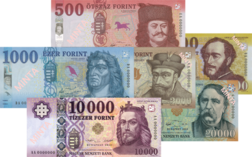Our website is made possible by displaying online advertisements to our visitors.
Please consider supporting us by disabling your ad blocker.
Hungarian forint
| Magyar forint (Hungarian) | |
|---|---|
 Hungarian forint banknotes | |
| ISO 4217 | |
| Code | HUF (numeric: 348) |
| Subunit | 0.01 |
| Unit | |
| Plural | forintok (nominative only) |
| Symbol | Ft |
| Denominations | |
| Subunit | |
| 1⁄100 | fillér (defunct) |
| Banknotes | 500 Ft, 1,000 Ft, 2,000 Ft, 5,000 Ft, 10,000 Ft, 20,000 Ft |
| Coins | |
| Freq. used | 5 Ft, 10 Ft, 20 Ft, 50 Ft, 100 Ft, 200 Ft |
| Demographics | |
| Date of introduction | 1 August 1946 |
| Replaced | Hungarian adópengő |
| User(s) | |
| Issuance | |
| Central bank | Hungarian National Bank |
| Website | mnb |
| Printer | Hungarian Banknote Printing Company |
| Website | penzjegynyomda |
| Mint | Hungarian Mint Ltd. |
| Website | penzvero |
| Valuation | |
| Inflation | 3.8% (January 2024) |
| Source | ksh |
| Method | CPI |
The forint (Hungarian pronunciation: [ˈforint] ⓘ, sign Ft; code HUF) is the currency of Hungary. It was formerly divided into 100 fillér, but fillér coins are no longer in circulation. The introduction of the forint on 1 August 1946 was a crucial step in the post-World War II stabilisation of the Hungarian economy, and the currency remained relatively stable until the 1980s. Transition to a market economy in the early 1990s adversely affected the value of the forint; inflation peaked at 35% in 1991. Between 2001 and 2022, inflation was in single digits, and the forint has been declared fully convertible.[1] In May 2022, inflation reached 10.7% amid the Russian invasion of Ukraine and economic uncertainty.[2] As a member of the European Union, the long-term aim of the Hungarian government may be to replace the forint with the euro, although under the current government there is no target date for adopting the euro.[3]
- ^ BBC News Hungary lifts last currency restrictions. 18 June 2001
- ^ "1.1.1.2. Consumer price index by aggregate groups of consumption, and consumer price index for pensioners". www.ksh.hu. Retrieved 16 July 2022.
- ^ Szakacs, Gergely (18 October 2021). "Hungary's new opposition PM candidate wants stronger ties with EU". Reuters. Retrieved 16 January 2022.
Previous Page Next Page


